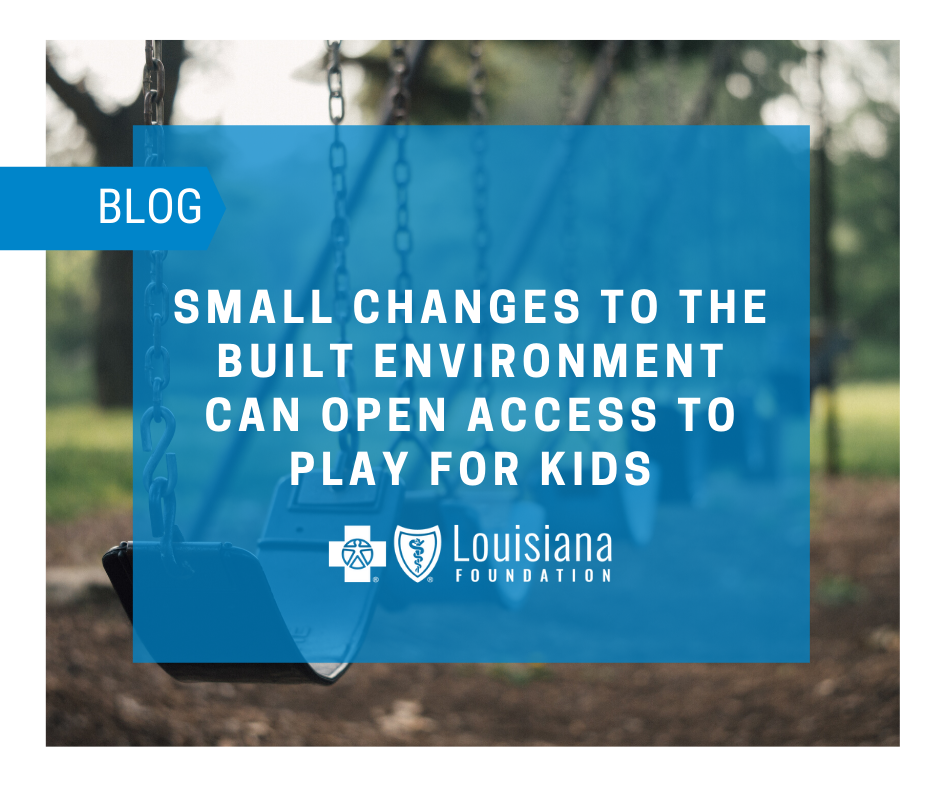Research continues to expound on the relationship between health and the built environment. In particular, there is a well-documented gulf in access to adequate public spaces within communities that are a majority people of color, especially so for those that are low-income, and even more so for those that are outside of urban areas.
The distribution of safe, engaging play spaces for young people is especially important as we consider the generational trends in increased obesity and shortened life expectancy. Funding for health issues has often been triaged – addressing access to direct care, food and necessities gets priority. Meanwhile, something like the built environment gets pushed aside.
And yet we know that these social and community determinants of health account for the majority of the differences in outcomes we see between ZIP codes. In light of the clear data about activity and play leading to better outcomes for kids, funders and communities must ask whether we are doing enough to make safe play available to all. Play, after all, is more than just about physical wellness. Outdoor play is increasingly linked to emotional wellbeing and development.
As we continue to work to make equitable, healthy play available for all in Louisiana and across the country, I wanted to share some news about two projects we funded in the last year that show promising results and interesting innovations on this important topic.
The first is the Arts Council of Greater Baton Rouge’s heART Trail in downtown Baton Rouge, which was funded through our New Horizons grant program and had its ribbon-cutting last Friday (Valentine’s Day). The heART Trail uses existing infrastructure to develop heart-shaped walking trails throughout Baton Rouge complete with wayfinding temporary and permanent art. The trails are also designed to celebrate neighborhoods and city’s “trailblazers,” as well as historic landmarks, parks, and businesses along the paths.
With additional funding from the Baton Rouge General Foundation, this project is an interesting exploration of whether enhancing and reframing the built environment that already exists can have a positive impact not just in terms of getting people moving, but in redefining certain corridors as walkable and open for business. We’re excited to see the numbers over the next year.
Speaking of enhancements to the built environment, our partners at Pennington Biomedical Research Center have recently completed a study in playground stenciling for childcare centers and preschools, also funded with a New Horizons grant. There are more than 1,300 licensed childcare centers across the state, and their access to play structures varies wildly. With tools to create physical play that are accessible at minimal cost, childcare centers can have a big impact on helping children learn healthy behaviors, curb excess weight gain, and contribute to fundamental motor skill development.
Measuring the effectiveness of these painted playgrounds was backed by a rigorous methodology. Those children whose schools incorporated painted playgrounds engaged in light intensity physical activity for an average of 24 minutes more than their peers.
The children continue to play by playing within the painted playgrounds, making up their own games and learning academic concepts like color and numbers. It’s been a huge success. You can see a short video about painted playgrounds here and, I’m happy to say, you can download the Painted Playgrounds toolkit on the Louisiana Department of Health’s Well Ahead website.
These two examples join other projects we’ve funded related to the equitable play, including BREC on the Geaux, support for Ruston’s Rock Island Greenway, the Smiles Park in Monroe and many more. To be clear – all kids deserve equal access to great spaces to play. While we continue to work on programs and policy to make that a reality, creative projects like the heART Trail and Pennington’s painted playgrounds can help make safe, engaging changes to the built environment available right now.
Do you have a project in mind that would contribute to equitable access to safe play? Are you in an area where adjusting the built environment is yielding results? We’d love to hear from you. And, don’t forget, our next grant deadline is March 1, 2020.
– Michael Tipton
President, Blue Cross and Blue Shield of Louisiana Foundation
Head of Community Relations
michael.tipton@bcbsla.com
Subscribe to our mailing list
